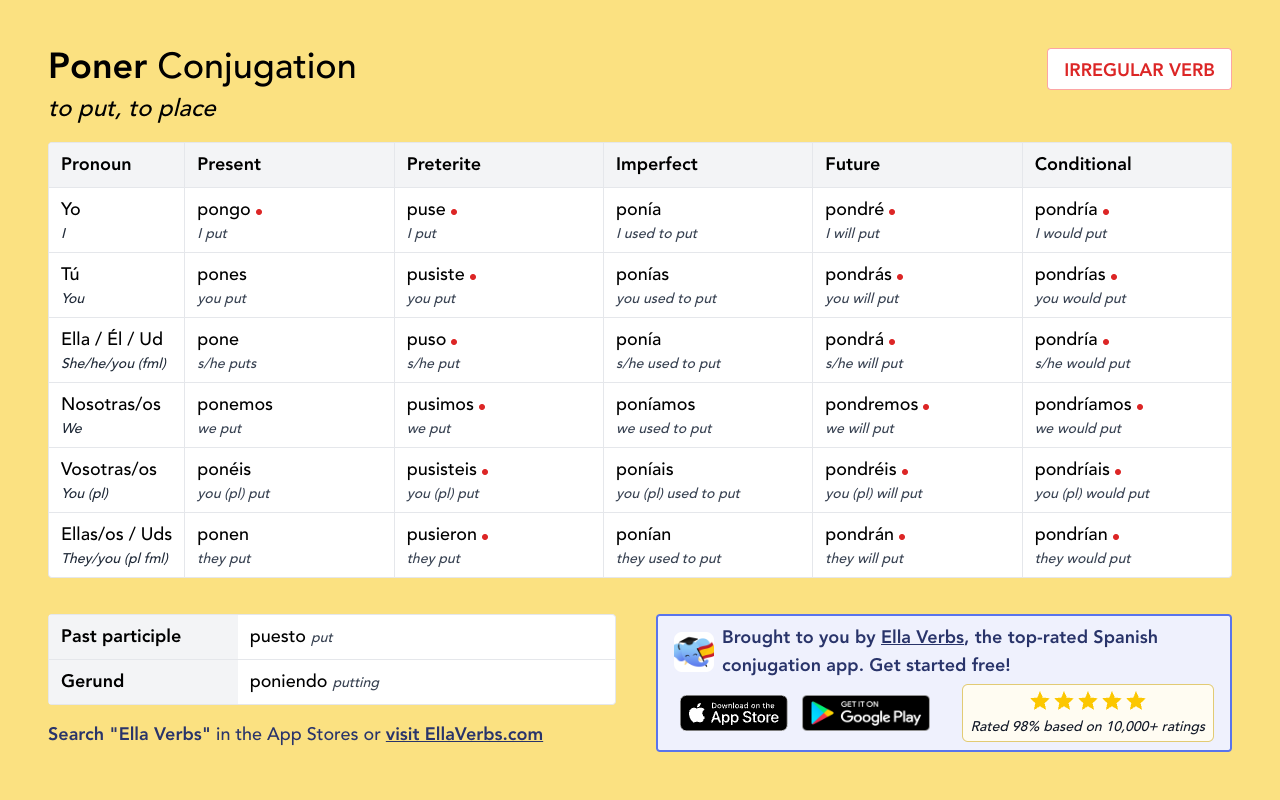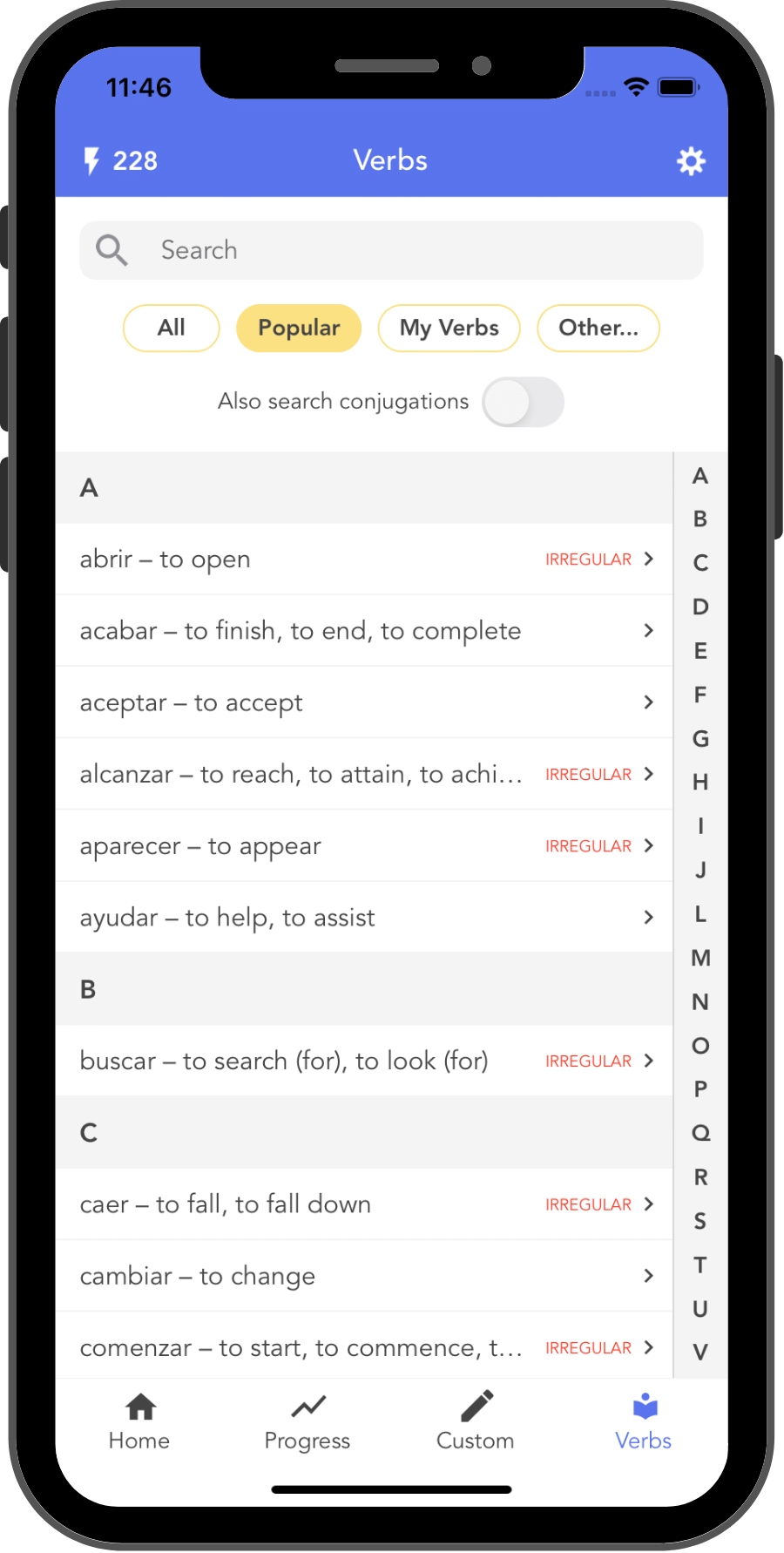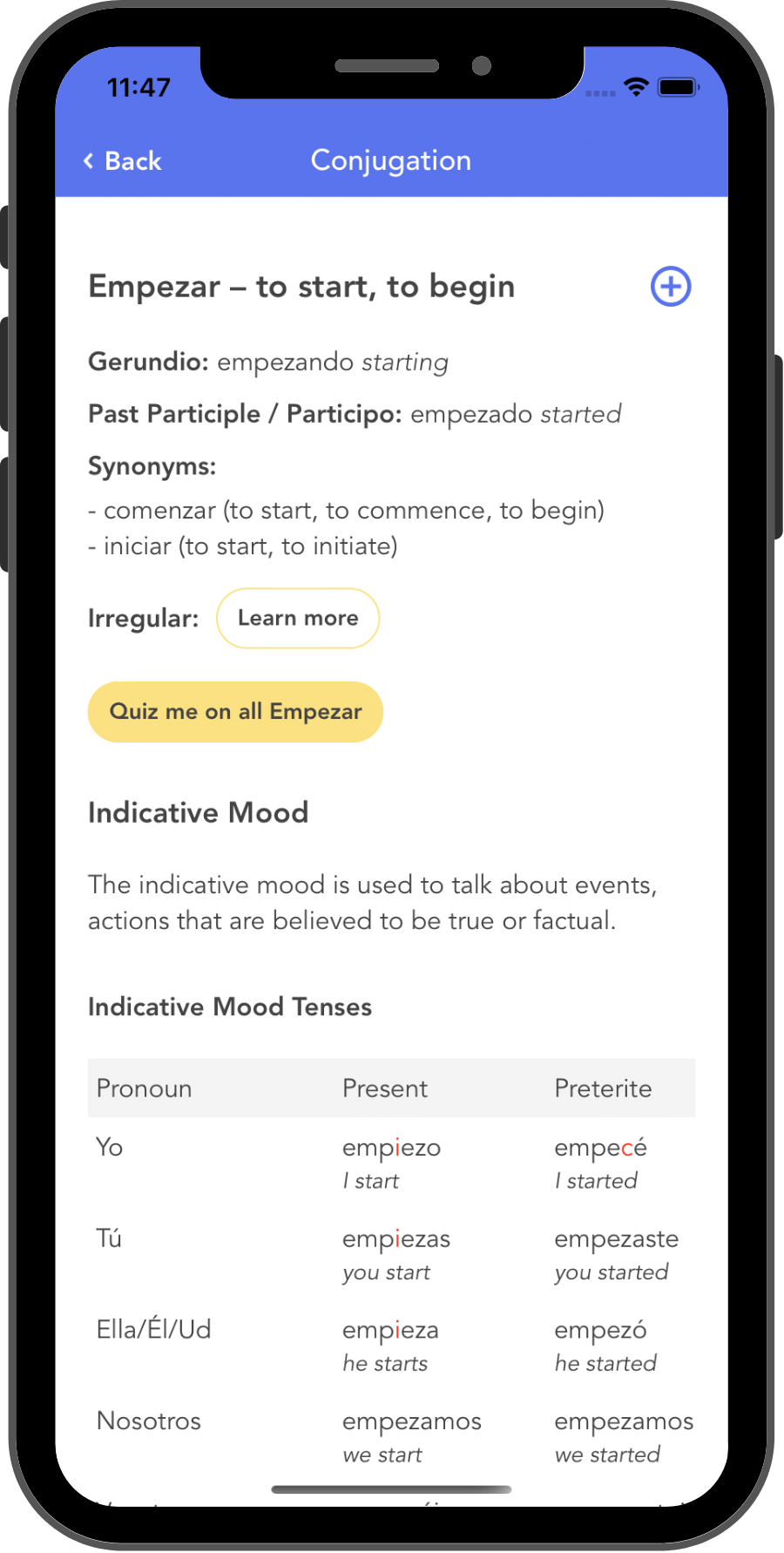 Ella Verbs
Ella VerbsHow to conjugate Poner in Spanish
To put, to place Irregular Verb Top 100
Table of Contents
- Introduction
- Indicative tenses of Poner
- Poner in the Indicative Present
- Poner in the Indicative Preterite
- Poner in the Indicative Imperfect
- Poner in the Indicative Present Continuous
- Poner in the Indicative Informal Future
- Poner in the Indicative Future
- Poner in the Indicative Conditional
- Poner in the Indicative Present Perfect
- Poner in the Indicative Past Perfect
- Poner in the Indicative Future Perfect
- Poner in the Indicative Conditional Perfect
- Subjunctive tenses of Poner
- Imperative tenses of Poner
- Example sentences and usage
- Downloadable cheat sheet (PDF)
- Practice Poner conjugations (free mobile app)
Introduction
Poner is the Spanish verb meaning "to put or to place". It can be used literally and figeratively, for example: "I put cheese on the pizza" and "he put me in a difficult position". It can be used when talking about turning on the television, the lights, or the heating, as well as to talk about putting on clothes, for example: "Hoy me pongo un vestido" (Today I put on a dress).
Similar verbs to poner include: colocar (to place), depositar (to deposit / place).
| Item | Spanish | English |
|---|---|---|
| Infinitive | poner | to put, to place |
| Past participle | puesto | put |
| Gerund | poniendo | putting |
Indicative Tenses of Poner
Poner in the Indicative Present
The Indicative Present of poner is used to talk about situations, events or thoughts that are happening now or in the near future. It is also used to talk about facts and truths. For example, "pongo las verduras en la nevera", meaning "I put the vegetables in the fridge".
In Spanish, the Indicative Present is known as "El Presente".
| Pronoun | Spanish | English |
|---|---|---|
| Yo | pongo | I put |
| Tú | pones | you put |
| Ella / Él / Usted | pone | s/he puts, you (formal) put |
| Nosotras / Nosotros | ponemos | we put |
| Vosotras / Vosotros | ponéis | you (plural) put |
| Ellas / Ellos / Ustedes | ponen | they put |
The red dot () above denotes an irregular conjugation.
Back to top
Poner in the Indicative Preterite
The Indicative Preterite of poner is used to talk about actions completed in the past, at a specific point in time. For example, "puse las verduras en la nevera", meaning "I put the vegetables in the fridge".
In Spanish, the Indicative Preterite is known as "El Pretérito Indefinido".
| Pronoun | Spanish | English |
|---|---|---|
| Yo | puse | I put |
| Tú | pusiste | you put |
| Ella / Él / Usted | puso | s/he put, you (formal) put |
| Nosotras / Nosotros | pusimos | we put |
| Vosotras / Vosotros | pusisteis | you (plural) put |
| Ellas / Ellos / Ustedes | pusieron | they put |
The red dot () above denotes an irregular conjugation.
Back to top
Poner in the Indicative Imperfect
The Indicative Imperfect of poner is used to describe regular and repeated actions that happened in the past and descriptions of things you used to do. For example, "ponía las verduras en la nevera", meaning "I used to put the vegetables in the fridge".
In Spanish, the Indicative Imperfect is known as "El Pretérito Imperfecto".
| Pronoun | Spanish | English |
|---|---|---|
| Yo | ponía | I used to put |
| Tú | ponías | you used to put |
| Ella / Él / Usted | ponía | s/he used to put, you (formal) used to put |
| Nosotras / Nosotros | poníamos | we used to put |
| Vosotras / Vosotros | poníais | you (plural) used to put |
| Ellas / Ellos / Ustedes | ponían | they used to put |
Back to top
Poner in the Indicative Present Continuous
The Indicative Present Continuous of poner is used to talk about something that is happening continuously or right now. For example, "estoy poniendo las verduras en la nevera", meaning "I am putting the vegetables in the fridge".
In Spanish, the Indicative Present Continuous is known as "El Presente Progresivo".
| Pronoun | Spanish | English |
|---|---|---|
| Yo | estoy poniendo | I am putting |
| Tú | estás poniendo | you are putting |
| Ella / Él / Usted | está poniendo | s/he is putting, you (formal) are putting |
| Nosotras / Nosotros | estamos poniendo | we are putting |
| Vosotras / Vosotros | estáis poniendo | you (plural) are putting |
| Ellas / Ellos / Ustedes | están poniendo | they are putting |
Back to top
Poner in the Indicative Informal Future
The Indicative Informal Future of poner is used to talk about something that will happen in the future, especially in the near future. For example, "voy a poner las verduras en la nevera", meaning "I am going to put the vegetables in the fridge".
In Spanish, the Indicative Informal Future is known as "El Futuro Próximo".
| Pronoun | Spanish | English |
|---|---|---|
| Yo | voy a poner | I am going to put |
| Tú | vas a poner | you are going to put |
| Ella / Él / Usted | va a poner | s/he is going to put, you (formal) are going to put |
| Nosotras / Nosotros | vamos a poner | we are going to put |
| Vosotras / Vosotros | vais a poner | you (plural) are going to put |
| Ellas / Ellos / Ustedes | van a poner | they are going to put |
Back to top
Poner in the Indicative Future
The Indicative Future of poner is used to talk about something that will happen in the future. For example, "pondré las verduras en la nevera", meaning "I will put the vegetables in the fridge".
In Spanish, the Indicative Future is known as "El Futuro Simple".
| Pronoun | Spanish | English |
|---|---|---|
| Yo | pondré | I will put |
| Tú | pondrás | you will put |
| Ella / Él / Usted | pondrá | s/he will put, you (formal) will put |
| Nosotras / Nosotros | pondremos | we will put |
| Vosotras / Vosotros | pondréis | you (plural) will put |
| Ellas / Ellos / Ustedes | pondrán | they will put |
The red dot () above denotes an irregular conjugation.
Back to top
Poner in the Indicative Conditional
The Indicative Conditional of poner is used to talk about something that may happen in the future, hypothesis and probabilities. For example, "pondría las verduras en la nevera", meaning "I would put the vegetables in the fridge".
In Spanish, the Indicative Conditional is known as "El Condicional Simple".
| Pronoun | Spanish | English |
|---|---|---|
| Yo | pondría | I would put |
| Tú | pondrías | you would put |
| Ella / Él / Usted | pondría | s/he would put, you (formal) would put |
| Nosotras / Nosotros | pondríamos | we would put |
| Vosotras / Vosotros | pondríais | you (plural) would put |
| Ellas / Ellos / Ustedes | pondrían | they would put |
The red dot () above denotes an irregular conjugation.
Back to top
Poner in the Indicative Present Perfect
The Indicative Present Perfect of poner is used to describe actions that started recently (in the past) and are still happening now or things that have been done recently. For example, "he puesto las verduras en la nevera", meaning "I have put the vegetables in the fridge".
In Spanish, the Indicative Present Perfect is known as "El Pretérito Perfecto".
| Pronoun | Spanish | English |
|---|---|---|
| Yo | he puesto | I have put |
| Tú | has puesto | you have put |
| Ella / Él / Usted | ha puesto | s/he has put, you (formal) have put |
| Nosotras / Nosotros | hemos puesto | we have put |
| Vosotras / Vosotros | habéis puesto | you (plural) have put |
| Ellas / Ellos / Ustedes | han puesto | they have put |
The red dot () above denotes an irregular conjugation.
Back to top
Poner in the Indicative Past Perfect
The Indicative Past Perfect of poner is used to talk about actions that happened before another action in the past. For example, "había puesto las verduras en la nevera", meaning "I had put the vegetables in the fridge".
In Spanish, the Indicative Past Perfect is known as "El Pretérito Pluscuamperfecto".
| Pronoun | Spanish | English |
|---|---|---|
| Yo | había puesto | I had put |
| Tú | habías puesto | you had put |
| Ella / Él / Usted | había puesto | s/he had put, you (formal) had put |
| Nosotras / Nosotros | habíamos puesto | we had put |
| Vosotras / Vosotros | habíais puesto | you (plural) had put |
| Ellas / Ellos / Ustedes | habían puesto | they had put |
The red dot () above denotes an irregular conjugation.
Back to top
Poner in the Indicative Future Perfect
The Indicative Future Perfect of poner is used to talk about something that will have happened in the future after something else has already happened. For example, "habré puesto las verduras en la nevera", meaning "I will have put the vegetables in the fridge".
In Spanish, the Indicative Future Perfect is known as "El Futuro Perfecto".
| Pronoun | Spanish | English |
|---|---|---|
| Yo | habré puesto | I will have put |
| Tú | habrás puesto | you will have put |
| Ella / Él / Usted | habrá puesto | s/he will have put, you (formal) will have put |
| Nosotras / Nosotros | habremos puesto | we will have put |
| Vosotras / Vosotros | habréis puesto | you (plural) will have put |
| Ellas / Ellos / Ustedes | habrán puesto | they will have put |
The red dot () above denotes an irregular conjugation.
Back to top
Poner in the Indicative Conditional Perfect
The Indicative Conditional Perfect of poner is used to talk about something that would have happened in the past but didn’t due to another action. For example, "habría puesto las verduras en la nevera", meaning "I would have put the vegetables in the fridge".
In Spanish, the Indicative Conditional Perfect is known as "El Condicional Perfecto".
| Pronoun | Spanish | English |
|---|---|---|
| Yo | habría puesto | I would have put |
| Tú | habrías puesto | you would have put |
| Ella / Él / Usted | habría puesto | s/he would have put, you (formal) would have put |
| Nosotras / Nosotros | habríamos puesto | we would have put |
| Vosotras / Vosotros | habríais puesto | you (plural) would have put |
| Ellas / Ellos / Ustedes | habrían puesto | they would have put |
The red dot () above denotes an irregular conjugation.
Back to top
Subjunctive Tenses of Poner
Poner in the Subjunctive Present
The Subjunctive Present is used to talk about situations of uncertainty, or emotions such as wishes, desires and hopes. It differs from the indicative mood due to the uncertainty of the events which are being spoken about. For example, "ponga", meaning "I put".
In Spanish, the Subjunctive Present is known as "El Presente de Subjuntivo".
| Pronoun | Spanish | English |
|---|---|---|
| Yo | ponga | I put |
| Tú | pongas | you put |
| Ella / Él / Usted | ponga | s/he puts, you (formal) put |
| Nosotras / Nosotros | pongamos | we put |
| Vosotras / Vosotros | pongáis | you (plural) put |
| Ellas / Ellos / Ustedes | pongan | they put |
The red dot () above denotes an irregular conjugation.
Back to top
Poner in the Subjunctive Imperfect
The Subjunctive Imperfect is used to speak about unlikely or uncertain events in the past or to cast an opinion (emotional) about something that happened in the past. For example, "pusiera", meaning "I put".
In Spanish, the Subjunctive Imperfect is known as "El Imperfecto Subjuntivo".
| Pronoun | Spanish | English |
|---|---|---|
| Yo | pusiera | I put |
| Tú | pusieras | you put |
| Ella / Él / Usted | pusiera | s/he put, you (formal) put |
| Nosotras / Nosotros | pusiéramos | we put |
| Vosotras / Vosotros | pusierais | you (plural) put |
| Ellas / Ellos / Ustedes | pusieran | they put |
The red dot () above denotes an irregular conjugation.
Back to top
Poner in the Subjunctive Future
The Subjunctive Future is used to speak about hypothetical situations, and actions/events that may happen in the future. For example, "pusiere", meaning "I will put".
In Spanish, the Subjunctive Future is known as "El Futuro de Subjuntivo".
| Pronoun | Spanish | English |
|---|---|---|
| Yo | pusiere | I will put |
| Tú | pusieres | you will put |
| Ella / Él / Usted | pusiere | s/he will put, you (formal) will put |
| Nosotras / Nosotros | pusiéremos | we will put |
| Vosotras / Vosotros | pusiereis | you (plural) will put |
| Ellas / Ellos / Ustedes | pusieren | they will put |
The red dot () above denotes an irregular conjugation.
Back to top
Poner in the Subjunctive Present Perfect
The Subjunctive Present Perfect is used to describe past actions or events that are still connected to the present day and to speak about an action that will have happened by a certain time in the future. For example, "haya puesto", meaning "I have put".
In Spanish, the Subjunctive Present Perfect is known as "El Pretérito Perfecto de Subjuntivo".
| Pronoun | Spanish | English |
|---|---|---|
| Yo | haya puesto | I have put |
| Tú | hayas puesto | you have put |
| Ella / Él / Usted | haya puesto | s/he has put, you (formal) have put |
| Nosotras / Nosotros | hayamos puesto | we have put |
| Vosotras / Vosotros | hayáis puesto | you (plural) have put |
| Ellas / Ellos / Ustedes | hayan puesto | they have put |
The red dot () above denotes an irregular conjugation.
Back to top
Poner in the Subjunctive Past Perfect
The Subjunctive Past Perfect is used to speak about hypothetical situations, and actions/events that occurred before other actions/events in the past. For example, "hubiera puesto", meaning "I had put".
In Spanish, the Subjunctive Past Perfect is known as "El Pretérito Pluscuamperfecto de Subjuntivo".
| Pronoun | Spanish | English |
|---|---|---|
| Yo | hubiera puesto | I had put |
| Tú | hubieras puesto | you had put |
| Ella / Él / Usted | hubiera puesto | s/he had put, you (formal) had put |
| Nosotras / Nosotros | hubiéramos puesto | we had put |
| Vosotras / Vosotros | hubierais puesto | you (plural) had put |
| Ellas / Ellos / Ustedes | hubieran puesto | they had put |
The red dot () above denotes an irregular conjugation.
Back to top
Poner in the Subjunctive Future Perfect
The Subjunctive Future Perfect is used to speak about something that will have happened if a hypothetical situations occurs in the future. For example, "hubiere puesto", meaning "I will have put".
In Spanish, the Subjunctive Future Perfect is known as "El Futuro Perfecto de Subjuntivo".
| Pronoun | Spanish | English |
|---|---|---|
| Yo | hubiere puesto | I will have put |
| Tú | hubieres puesto | you will have put |
| Ella / Él / Usted | hubiere puesto | s/he will have put, you (formal) will have put |
| Nosotras / Nosotros | hubiéremos puesto | we will have put |
| Vosotras / Vosotros | hubiereis puesto | you (plural) will have put |
| Ellas / Ellos / Ustedes | hubieren puesto | they will have put |
The red dot () above denotes an irregular conjugation.
Back to top
Imperative Tenses of Poner
Poner in the Imperative Affirmative
The Imperative Affirmative is used to give orders and commands, to tell someone to do something. For example, "ponga", meaning "(to you formal) put!".
In Spanish, the Imperative Affirmative is known as "El Imperativo Afirmativo".
| Pronoun | Spanish | English |
|---|---|---|
| Yo | - | - |
| Tú | pon | (to you) put! |
| Ella / Él / Usted | ponga | (to you formal) put! |
| Nosotras / Nosotros | pongamos | let's put! |
| Vosotras / Vosotros | poned | (to you plural) put! |
| Ellas / Ellos / Ustedes | pongan | (to you plural formal) put! |
The red dot () above denotes an irregular conjugation.
Back to top
Poner in the Imperative Negative
The Imperative Negative is used to give orders and commands, telling someone not to do something. For example, "no ponga", meaning "(to you formal) don't put!".
In Spanish, the Imperative Negative is known as "El Imperativo Negativo".
| Pronoun | Spanish | English |
|---|---|---|
| Yo | - | - |
| Tú | no pongas | (to you) don't put! |
| Ella / Él / Usted | no ponga | (to you formal) don't put! |
| Nosotras / Nosotros | no pongamos | let's not put! |
| Vosotras / Vosotros | no pongáis | (to you plural) don't put! |
| Ellas / Ellos / Ustedes | no pongan | (to you plural formal) don't put! |
The red dot () above denotes an irregular conjugation.
Back to top
Example sentences and usage
- Sería mejor que te pusieras un impermeable. You had better put on a raincoat.
- Pon el mazo de cartas sobre la mesa de roble. Place the deck of cards on the oaken table.
- Es un lío total y me pone de los nervios. It's a complete mess, and it's getting on my nerves.
- Sería mejor que te pusieras un impermeable. You had better put on a raincoat.
- Cuando tu negocio se ponga a andar, ahí hablaremos de un aumento. When your business gets rolling we'll talk about an increase.
- Espero que pronto te pongas bien. I hope that you will get well soon.
- El cielo se puso cada vez más oscuro. The sky became darker and darker.
- Me puse muy contento de ver a mi viejo amigo. Meeting my old friend was very pleasant.
Back to top
Downloadable cheat sheets
Download and print a cheat sheet of Poner Spanish conjugation tables in image or PDF format:

Back to top
Practice Poner conjugations (free mobile & web app)
Get full conjugation tables for Poner and 2,300+ other verbs on-the-go with Ella Verbs for iOS, Android, and web.
We also guide you through learning all Spanish tenses and test your knowledge with conjugation quizzes. Download it for free!


Back to top
About Ella Verbs
👋 Hola! We built Ella Verbs to help people (and ourselves!) master one of the hardest parts of Spanish – verb conjugation. It guides you through learning all tenses in an easy-to-follow way, giving you levels of bite-sized lessons and fun quizzes. Here is a 6 minute overview of all of the app's features:
It has changed a lot over the 6+ years we have been working on it, but the goal remains the same – to help you master Spanish conjugation! You can download and try it for free, and, if you do, please send any and all feedback our way!
- Jane & Brian
Back to top
Want to explore other verb conjugations?
Why not check out Ponerse – to put on, to place on or see the complete list of verbs here.
Back to top
Poner: to put, to place
Remove the mystery behind Spanish conjugation with Ella Verbs
- Learn how to conjugate (not just memorize)
- Discover & focus on your weaknesses
- Interactive quizzes that you actually learn from
- Free to try, and free forever for those who cannot afford it.
